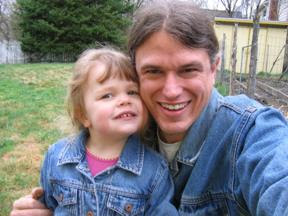I just tried both the methods listed below (Joinery 2 & 3). For the hanger-bolt joint (joinery 2), I omitted the epoxy, since I hoped to reuse the materials. For the mortise-and-tenon joint (joinery 3) I used a piece of 1/8" ply cut in a modified rectangle for the tenon and bamboo skewers for pins. The modification was essentially a tail, an extention of the rectangle at a width slightly less, so that it could slide inside the cavity of the crosspole, giving more pinning length while requiring the bamboo to be cut less.
Hanger-Bolt Joint
Joining caused splitting of the hardwood dowel, and subsequent stress and splitting of the crosspole. Joint was not square. No problems with compression of the bamboo from the bolt. There was minimal wiggling in the joint, but when I applied pressure the screw of the hanger-bolt pulled out of the dowel, due to its split.
The non-squareness of the joint was likely due to the difficulty I had centering the hole for the screw-side of the hanger-bolt, and making the hole perpendicular. Also, I did not perfect the curvature of the crosspole cut to fit the main pole. The splitting dowel was encouraged because of the difficulty getting a snug fit between the dowel and the bamboo cavity.
Also, screwing in the hanger-bolt is challenging.
Mortise and Tenon Joint
Fitting the mortise-and-tenon to each other was easily done with a dremel. Getting a tight fit was not difficult (the hanger bolt pulls the parts together in the other joint, in this joint this must be done manually). Pins held without glue. The resulting joint was square with minimal wiggling. However, when force was applied, the wiggling gradually increased. Eventually, pins cracked, one failed entirely, and the tenon tail split off.
Conclusions
I like the mortise-and-tenon joint, despite its failures. 1/4" ply and larger diameter pins (bamboo chopsticks? wood dowels?) will improve strength. Epoxy in the joint will not only give adhesion, put will also fill gaps and minimize the wiggling. Triangulating joints will also minimize wiggling. If wiggling can be eliminated, the progressive growth in wiggling should also disappear.
Most important, of course, was the ease with which I was able to get a good-looking joint. Precision is not a strength of mine, so any method that doesn't require me to hold my drill perfectly vertical is a better method.
Thursday, July 31, 2008
Subscribe to:
Post Comments (Atom)





No comments:
Post a Comment